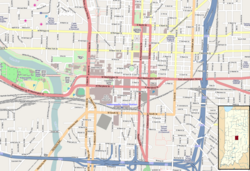Indianapolis White Castle #3 | |
 The building in April 2015 | |
| Location | 660 Fort Wayne Avenue Indianapolis, Indiana United States |
|---|---|
| Coordinates | 39°46′36″N86°09′16″W / 39.7766°N 86.1545°W |
| Built | 1927 |
| Architect | Lloyd W. Ray |
| Architectural style | 20th century functional |
| NRHP reference No. | 11000385 [1] |
| Added to NRHP | June 23, 2011 |
The Indianapolis White Castle #3 was built in 1927 and is located on Fort Wayne Avenue in Indianapolis, Indiana. The building is the third oldest still standing restaurant building from the White Castle hamburger chain in the United States, and the oldest White Castle building in Indiana. [2]





